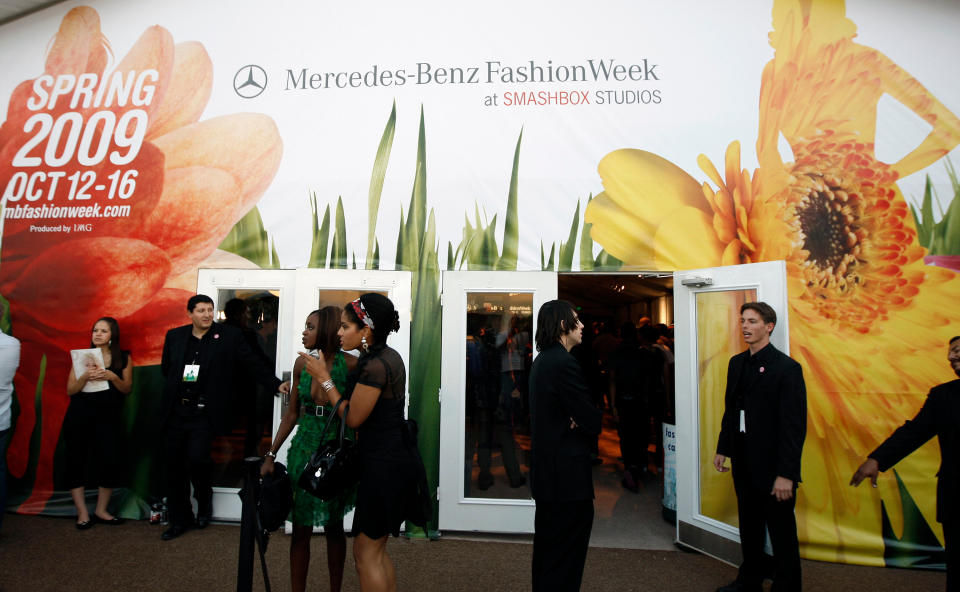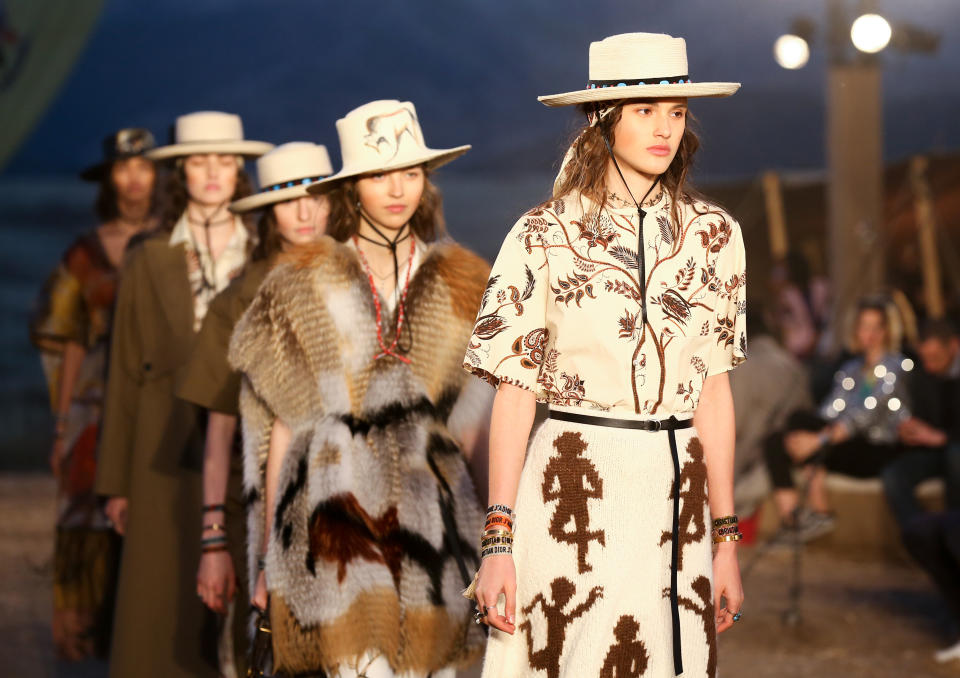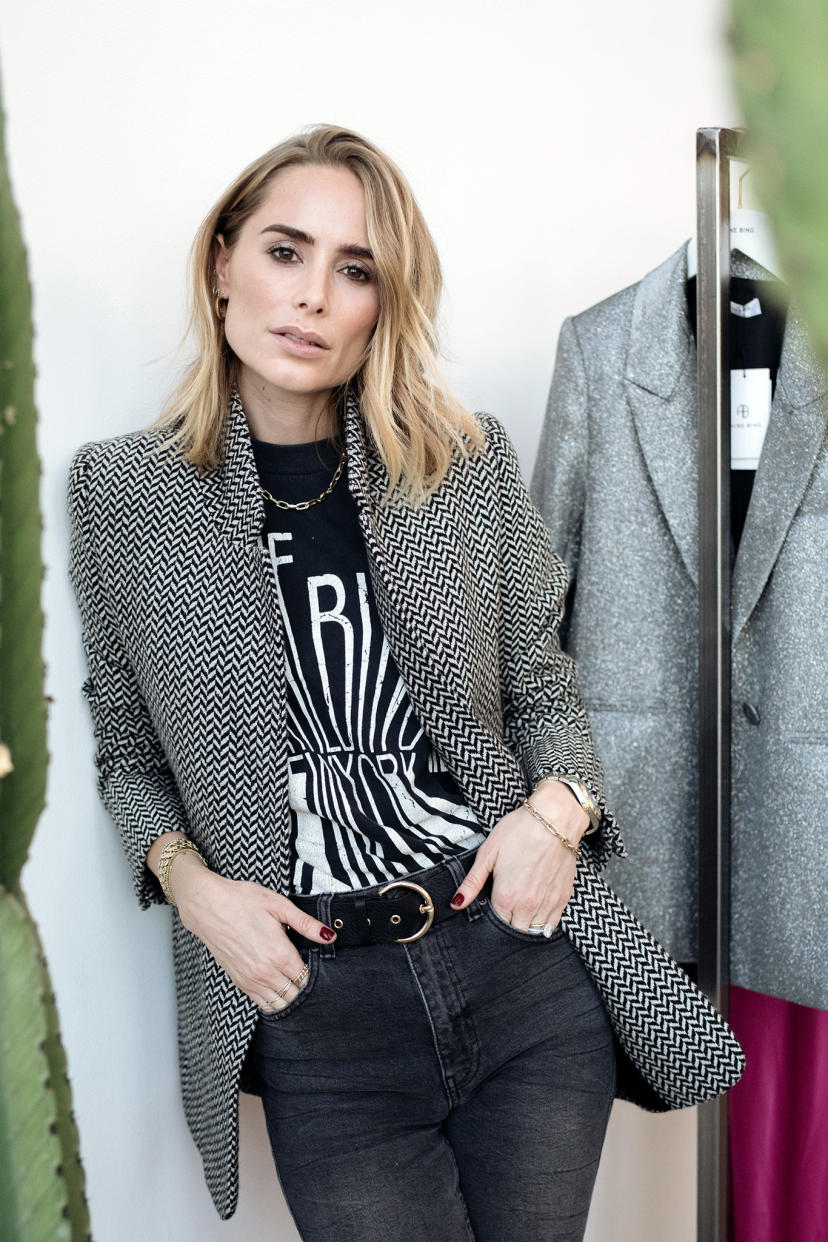Is L.A. the Future of the American Runway?

LOS ANGELES — Has the time come for Los Angeles to take the lead?
Hollywood hero Tom Ford being elected chairman of the Council of Fashion Designers of America, and L.A.-born label Rodarte staging a spectacular flower-filled February runway show at the Huntington Library, Art Collections and Botanical Gardens in San Marino, Calif., are two signs that the industry could finally consider having an organized fashion week or series of runway events here. The idea is especially compelling now that the next Oscars date — Feb. 9, 2020 — will overlap with New York Fashion Week’s fall 2020 season, and sponsorship opportunities for shows in New York are becoming harder to find.
Related stories
L.A.-Based Designers and Brands Who Are Moving the Market and Beyond
Street Signs: Peaches Looks to New Capital to Support Growth
The Wing Links With Time's Up on Events, Programming
“The talent is here,” said Elyse Walker, the longtime L.A. retailer with luxury multilabel boutiques in the Pacific Palisades and Newport Beach, and the fashion director of online site Fwrd by Elyse Walker. “And everyone wants to be in L.A. or come to L.A. I think, if you build it they will come.”
Seven years after Hedi Slimane brought his Saint Laurent atelier and international attention to the SoCal style scene, L.A. is still rising. The Frieze L.A. Art Fair had a successful debut in February at Paramount Studios with a temporary fashion town house from Matchesfashion.com, the Obamas have set up their own production company at Netflix, and the Academy Museum of Motion Pictures and Lucas Museum of Narrative Art are both under construction. Money continues to pour in from entertainment, digital media firms and burgeoning cannabis brands, all of which could potentially partner on or sponsor fashion events. (L.A. billionaire beverage maven and arts patron Lynda Resnick helped underwrite Rodarte’s February show, which acted as a launch for her JNSQ Rose Cru Wine.) And LVMH Moët Hennessy Louis Vuitton is betting on L.A. by buying up real estate around Rodeo Drive to potentially develop a property for its Cheval Blanc hotel.
But nowhere in the recent cultural renaissance has the idea of creating a real L.A. Fashion Week come up — until now.
“It’s almost like enough time has gone by that L.A. Fashion Week doesn’t sound like a bad idea…it sounds like a good idea,” said Jonathan Simkhai, the New York designer, who last year moved his business — atelier and all — to a 1,200-square-foot retail/workspace in West Hollywood, and points to the plethora of interesting show locations in L.A. as compared to New York as a major selling point. “I would like to get a few more designers together and talk about partnering up, finding a time when it’s appropriate, when we can make sure the models and editors are here,” said Simkhai, who shows at New York Fashion Week. “I think it would benefit everyone if we piggybacked on each other.”
L.A.’s design output has broadened far beyond denim and casualwear — though it still has that, too, plus cutting-edge men’s streetwear from Fear of God, Amiri and more — to include red carpet brands Tom Ford, Rodarte and Brock; modern minimalists Co, Rosetta Getty and Juan Carlos Obando, and resort lifestyle brands Cult Gaia, Rhode and Staud. While they may be showing and selling their collections elsewhere, these brands have built global stockists and followings as big as many of their New York counterparts. Add to that the city’s relatively affordable real estate, limitless space and rich manufacturing resources continuing to draw creatives from elsewhere looking for entrepreneurial opportunity or a lifestyle change, and L.A. is becoming a viable fashion industry alternative to New York.
The fashion sector in Los Angeles County already employs 24% more workers than the fashion sector in New York City, according to Otis College of Art and Design’s annual report on California’s creative economy, and demand for skilled work is rising as brands expand.

CFDA award nominees Sarah Staudinger and George Augusto, cofounders of the Echo Park-based brand Staud, maker of Insta-loved bucket bags and ready-to-wear, took their collection to New York Fashion Week when they started in 2016, but now feel like their business — and L.A.’s creative clout — have grown enough to show at home.
“Year one, we were direct-to-consumer so it was all about developing product and understanding our customer. Then when we made the decision to start wholesaling, we knew we had to take it to market in New York because that’s where all the buyers and influencers were,” Staudinger said. “With that said, since our last show, we have been talking about doing something here, how that would work and what it would look like. Especially with the art scene happening in L.A., we’re ready to do something here and contribute.”

“There are so many incredible opportunities in New York, but brands are also realizing that they can choose how and where they want to show depending on the collection,” said Rodarte designers Kate and Laura Mulleavy, who had the advantage of being able to bring their world-class team, including show producer Alex de Betak and Bureau Betak, to make sure their L.A. show was up to par.
L.A.’s scattered runway history
Over the years, runway shows have waxed and waned in popularity — and quality — in L.A.. In the Forties, when California’s fashion swimwear manufacturers drew editors and buyers from all over the country to L.A. Market Week, swimwear pioneer Fred Cole hosted fashion shows around the pool at his Beverly Hills mansion, where silver screen mermaid Esther Williams was the star attraction. And Hollywood studio costume designer and California couturier Irene Gibbons previewed her collections for Marlene Dietrich and other clients at department store Bullocks Wilshire.
As New York emerged as the center of designer sportswear in the Fifties and Sixties, it became the focal point for the American runway shows and market weeks, drawing L.A.’s design talent, including Gilbert Adrian, Edith Head and later James Galanos and Bob Mackie, as well as casual brands like BCBG and Bebe. But there have always been plenty of one-off events in L.A., including a show in 1976 at the Pacific Design Center that showcased the work of Rudi Gernreich, Holly Harp and other designers of California’s then “new wave” for retailers and press.

In the Nineties and early Aughts, buoyed by the success of premium denim and celeb-loved casual brands like Juicy Couture, homegrown talent began to assert itself in L.A., showing everywhere from gritty downtown alleys to the beach. That indie spirit continued to shape the fashion scene here, even as the IMG-owned 7th on Sixth partnered with L.A.’s Smashbox Studios to harness the city’s geographically diverse talent into organized fashion weeks from 2003 to 2008, inviting out-of-town press and buyers to see collections from Rock & Republic denim to Jeremy Scott at a multi-runway venue in Culver City. But scheduling always prevented those shows from having much international impact because they fell at the tail end of the runway show cycle, when editors and buyers were reluctant to add more travel time and budget to their priority lists.
What’s changed in the last decade is that you can really show — and work — anywhere, and the digital fashion revolution has made it possible to launch a brand outside of the system via Instagram and celebrity influencers. With its appealing natural landscape and celebrity adjacency, L.A. has not only become an ideal scenic backdrop for producing fashion content, it has also become attractive to transplants and visitors. Why shouldn’t it be American fashion’s backlot?
Once fashion outsiders started to move in, led by Slimane and his Saint Laurent studio in 2012 (he has since moved back to Europe), L.A.’s already burgeoning style scene started to gain worldwide attention from media and luxury brands, who brought their own moveable runways to the city’s varied locations. To date, Tom Ford, Saint Laurent, Louis Vuitton, Dior, Burberry, Moschino, Hermès, Tommy Hilfiger, Rebecca Minkoff, Opening Ceremony and Rachel Comey have all presented one-off shows in or around L.A., with plenty of celebrity attendees in their front rows. The CFDA/Vogue Fashion Fund has also for the last decade staged its annual designer finalists show for the L.A. audience at the Chateau Marmont.

But none of the shows from smaller, L.A.-based designers has been able to achieve the same production value, or garner as much attention. Even WME-IMG’s annual venture Made L.A. — which from 2016 to 2018 offered a weekend’s worth of runway shows to the ticket-paying public from such L.A.-affiliated brands as Opening Ceremony, Jeremy Scott, Snoop Dogg for Joyrich and Wiz Khalifa for FourTwoFour — has struggled. This year’s event has been scrapped, and the concept is being rethought, according to a spokesperson for WME-IMG, which made another investment in L.A. when it opened a modeling division here in 2017.
So what’s left? This week, to coincide with market week at L.A.’s downtown showrooms, there are two runway events: Art Hearts Fashion, March 21 to 24 at the Majestic Downtown, which includes a kids runway show and collections from two “Project Runway” vets, Ricardo Seco and Kentaro Kameyama, who was actually scouted by casting agents while showing at a previous Art Hearts show; and L.A. Fashion Week, March 22 to 24 at the Petersen Automotive Museum, which includes headliner Naeem Khan rerunning the fall 2019 collection he debuted in New York last month, L.A. eveningwear designer Walter Mendez debuting his fall 2019 collection, and the Stories of Arabia group show featuring designers from Kuwait, Morocco, Oman and more, showing for a second time after their London Fashion Week debut.
Art Hearts Fashion “is less about reaching the industry than reaching people directly,” said Dean Shampagne, a spokesman for the event, noting that the shows’ audiences are a mix of fashion lovers, music and red carpet stylists, as well as some buyers and press.
Not everyone is impressed.
“Those are a little junior varsity for what we’re doing,” said Betsee Isenberg, whose Hatch and 10Eleven showrooms have helped build such L.A. brands as Rick Owens, Katayone Adeli, James Perse, Juicy Couture and, more recently, Current Elliott and A.L.C. “I support L.A. fashion, but we are trying to do big business here and that for me is a little small.”
L.A.’s potential
The CFDA under Ford’s chairmanship, which he begins in June, could draw on the power of L.A. art institutions, Hollywood studios and digital media to produce a buzzy runway event or showcase that crosses creative disciplines, perhaps even bringing in costume designers. “Creativity in Los Angeles is very fluid and Tom brings so much of that energy into his work, it will be exciting to see how that contributes to the growth of the CFDA,” said A.L.C. designer Andrea Lieberman, noting that Ford will bring a more global perspective “that will unite us more with the rest of the world.”
But some wonder if it would be a good idea to add another event — much less a week — to the global fashion calendar when they seem so outmoded already.
“Fashion weeks need to be rethought, period,” said Sarah Rutson, the former fashion director of Net-a-porter who is now chief brand officer of the L.A.-based Collected Group, composed of brands Equipment, Current Elliott and Joie. “Adding something like that in L.A. would be doing a disservice to what everyone is already doing here. This is a new world, a new era. It’s all about e-commerce and there’s so much opportunity for that here. Let’s stop talking in old ways.”
Zaid Affas, a new L.A.-based member of the CFDA who sells his luxe minimalist collection during market week in Paris, is concerned that an L.A. Fashion Week could be limiting for designers like him. “Europe can be very snobby in their approach to brands from other places; people like to put things into boxes — if you are American, you are commercial; if you are L.A., you are more casual…it’s been a hindrance sometimes.”
But he has let himself dream about doing something more creative in one of the many fabulous locales that would lend itself to a runway show in L.A., specifically an Art Deco building downtown. “If New York was L.A. physically, you could do much more interesting runway shows,” he said. (And certainly, brands have proven they can excite customers by rolling out the runway anywhere, from Tommy Hilfiger, Zendaya and her Hollywood stylist Law Roach in Paris earlier this month to Giorgio Armani heading to Tokyo for resort.)

Generating buzz outside the fashion system
Still, if the last decade has proven anything, it’s that the L.A. fashion scene is thriving without a traditional fashion week. Designers and brand builders have figured out other ways to generate buzz and sales — social media and influencers chief among them.
“I had been running a blog for years prior, so fortunately, I had a baked-in audience when I started my line,” said model/influencer/designer Anine Bing, who used Instagram to grow her contemporary collection with a rocker edge, now nine freestanding boutiques strong, with an early push from Kendall Jenner being photographed wearing the designer’s lace bralette during Coachella, which has been another magnet for L.A. fashion events in between the festival weekends in April. “We sold out instantly because her look went viral.”
“I am building a brand with a hashtag,” said red carpet stylist-turned-designer Karla Welch, who has collaborated with both Hanes and Levi’s on capsule collections promoted on social media with her xKarla hashtag, personal Instagram page with 200,000 followers, and through starry launch events like the Levi’s party she hosted at the L.A. Palladium with performances by SZA, Karen O and Lauryn Hill. (It should be said, that these types of events could be organized into a consolidated L.A. week, including for her next collection rollout in the fall.)
She also uses Instagram in her work as a celebrity stylist to discover — and give a platform to — local brands such as Marshmallow by Lady, which makes printed soft jersey dresses and leotards, as worn by Welch client Sarah Paulson in one of the stylist’s Instagram posts. “You can create a community through social media, so we scour and dig two steps deeper….That’s the new runway,” she said.
A post shared by Karla Welch (@karlawelchstylist) on Jan 24, 2019 at 5:12pm PST
Santa Barbara-born sisters Margaret and Katherine Kleveland have grown Doen, their L.A.-based direct-to-consumer brand of floaty feminine frocks and romantic accessories, in a similarly organic way with a message of female empowerment spread by grassroots marketing and word-of-mouth, largely through social media.
“Our goal has always been to offer a similar storytelling experience [to the runway] in an accessible way through our editorial content and social channels,” they said of their approach, which got the attention of Paris’ Bon Marché when the department store mounted an exhibition of L.A. brands in 2018. “We think of our social media as a mood board — comprised of vintage inspirational images and quotes, campaign photos as well as customers wearing our clothes — that offers our vision in a digestible way. Because of this, we feel our community can understand — and participate in — our story without the traditional showing at fashion week.”
Swan Top 🦢 with velvet ribbon in hair ❤️
A post shared by D Ô E N / @shopdoen (@shopdoen) on Mar 10, 2019 at 11:05am PDT
Thinking outside of the box is another way L.A. labels thrive. Stephanie Danan and Justin Kern, founders of the brand Co. which sells at Neiman Marcus and Net-a-porter, opened a showroom and selling space that symbolize how their clean and classic style fits into L.A.’s dramatic natural landscape. They have partnered with the MAK Center for Art and Architecture to maintain their collection at the modernist 1936 Rudolph Schindler-designed Fitzpatrick-Leland House, perched on a hill in Laurel Canyon, where they host events for buyers and customers and shoot look books. “There are no more rules in fashion. We decided never to have a runway show because first and foremost when you are small brand, it overextends the company to such a degree that it puts in peril what you need to launch, things like fabric and quality control,” said Danan, whose collection is sold primarily in Paris and Tokyo. “[The house] has been an amazing investment….I’ve seen a direct influence on perception of the brand and sales.”
A post shared by Co (@co) on Feb 27, 2019 at 9:05am PST
For others, the appeal of L.A. continues to be that it operates outside of the fashion system, offering designers the space to create — and run their businesses — in unorthodox ways.
“For me, it feels like all eyes are here because of the freedom we represent,” said Jesse Kamm, who has built a brand on high-waisted sailor-style Kamm pants — first launched in 2005 and sold at Bird Brooklyn, Kick Pleat and Mohawk General — and other spare, everyday basics. Kamm is part of L.A. fashion’s artisanal class, using sustainable or deadstock fabrics and local production to make just 8,000 pieces a year, with a cap on 30 retail accounts, so she can work nine months and spend the other three surfing in Costa Rica.
“The new luxury isn’t going into the airport and seeing everyone with a $1,500 Goyard bag. The new luxury is finding a niche thing you are into and there are only 500 in the world, and you have to seek it out and find it because it’s so rare,” she said, articulating one compelling reason to keep L.A. fashion small, protecting its cachet, rather than putting it on a larger runway platform. “It’s about the backlash to excess.”
A post shared by Jesse Kamm (@jessekamm) on Mar 14, 2019 at 8:34am PDT
Sign up for WWD's Newsletter. For the latest news, follow us on Twitter, Facebook, and Instagram.

